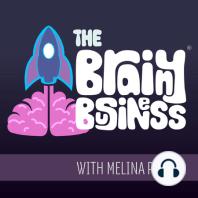50 min listen

259. Cognitive Semiotics and Metaphors with Sarah Thompson
FromThe Brainy Business | Understanding the Psychology of Why People Buy | Behavioral Economics
259. Cognitive Semiotics and Metaphors with Sarah Thompson
FromThe Brainy Business | Understanding the Psychology of Why People Buy | Behavioral Economics
ratings:
Length:
57 minutes
Released:
Feb 3, 2023
Format:
Podcast episode
Description
In today's conversation, I am joined by Sarah Thompson, a behavioral designer at Live Neuron Labs, who has a master's in cognitive semiotics. Don't worry, we are going to have lots of conversation today about what cognitive semiotics is and why it matters. The first thing I want to set the stage on is to get you thinking about metaphor. Now, this isn't the first time we are talking about metaphors (or semiotics) on the show, but today we are talking about how important metaphor really is when it comes to understanding the brain, thought, and decision-making. Metaphor matters because research is starting to show that we don't just use them as colorful language, but we actually think in metaphors. It's how our cognitive system is structured. Sarah will talk about a lot of great resources including a book called Metaphors We Live By, which was written by George Lakoff and Mark Johnson. If, like me, you are ready to go all in on cognitive semiotics and metaphor, this is a book to add to your library immediately. Cognitive semiotics is an emerging field, so we all need to stick together and know who else is researching and working in this space. Get ready to have your mind blown (metaphor) as you listen today! Show Notes: [00:43] In today's conversation, I am joined by Sarah Thompson, a behavioral designer at Live Neuron Labs, who has a master's in cognitive semiotics. [02:08] Cognitive semiotics is an emerging field, so we all need to stick together and know who else is researching and working in this space. [04:29] Sarah shares about herself, her background, and the work she does. She is a behavioral designer. Her job is to apply behavioral science through design to help people make better decisions. [06:10] Cognitive semiotics is how the mind makes meaning. [07:43] One of the biggest insights from cognitive semiotics is that metaphors are incredibly powerful at shaping how we talk, how we think, and how we make decisions. [08:21] Metaphors are something we don’t go out of our way to use. It is just something that naturally flows out of us. [10:55] We have this myth that metaphors are just a part of language but metaphors are actually in all other types of communication including gestures. [12:35] Melina talks about metaphor usage in songs, including what happens when something is unexpected. [14:21] In a metaphor we talk about one concept as if it is another concept. [16:50] A lot of studies show that the earlier you can get a metaphor in your conceptualization of an idea the more ability it has to influence how somebody thinks about it. It is not as effective if you add the metaphor at the end. [18:01] You are using metaphors constantly even when you are not thinking about them. [18:24] Sarah shares a study from Stanford University about two researchers who wanted to know if using a metaphor could affect how somebody thought about a complex social issue like crime. [20:07] A single word changed how people thought about a very complex social issue. The metaphor was more powerful at determining people’s response than their political affiliation. [23:03] We have primary metaphors which are ones that are deeply rooted and embodied metaphors. We acquire them from interactions with the world at a very young age. [25:36] The war metaphor was a mismatched metaphor for the pandemic. [26:56] Metaphors are a part of our everyday communication. They have the ability to influence us and they structure our thoughts. [29:20] The first key thing in using metaphors is identifying your user’s metaphors. [31:44] Once you know what your users are saying you can figure out those higher level conceptual metaphors they have. [33:04] Once you have their metaphors you need to evaluate them and figure out which of their metaphors align with the behavioral outcome we want them to do. [35:44] We have lots of ways where you can go and find what people are actually saying. [37:57] Some metaphors can be empowering, but others can be potent
Released:
Feb 3, 2023
Format:
Podcast episode
Titles in the series (100)
21. Habits: 95% Of Decisions Are Habitual - Which Side Is Your Business On?: Habits are much more powerful than most of us realize. This behavioral economics podcast is about habits and habitual buying. It is another one of my behavioral economics foundations podcasts. When a lot of us think of habits, we focus on bad habits,... by The Brainy Business | Understanding the Psychology of Why People Buy | Behavioral Economics